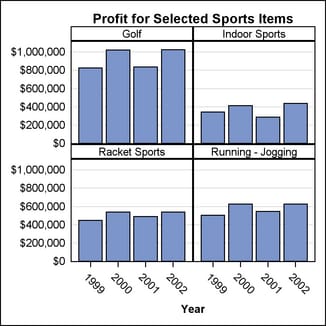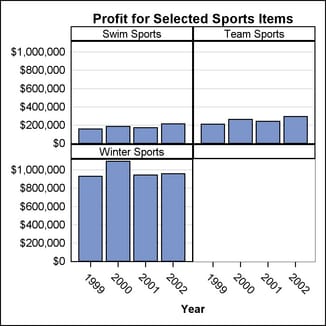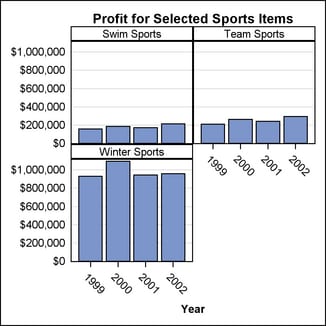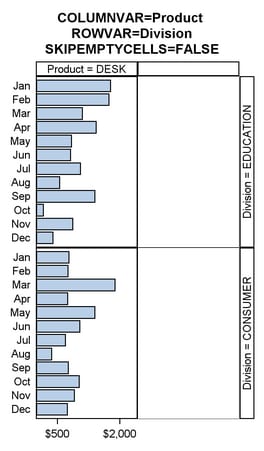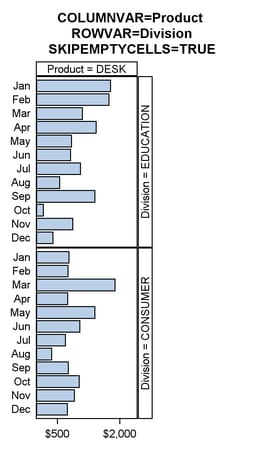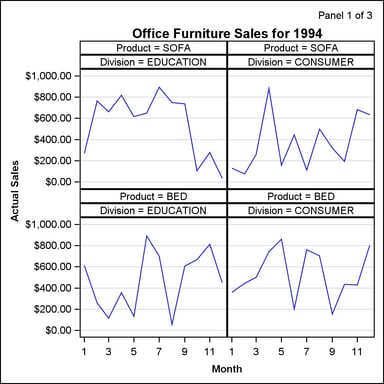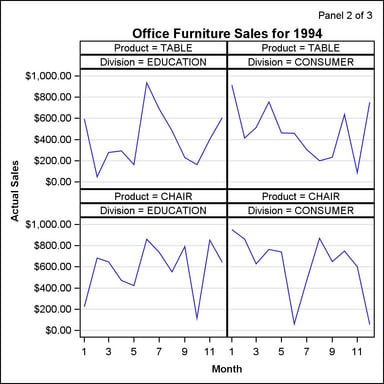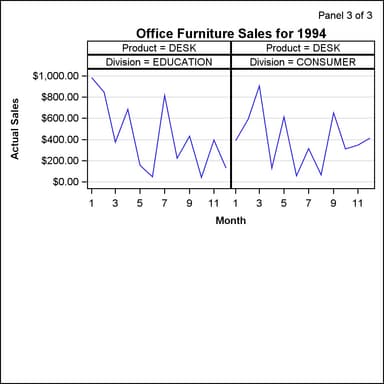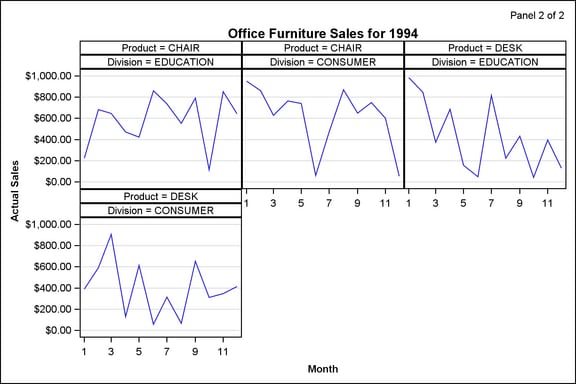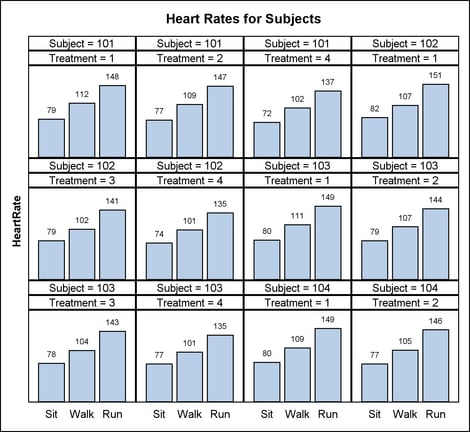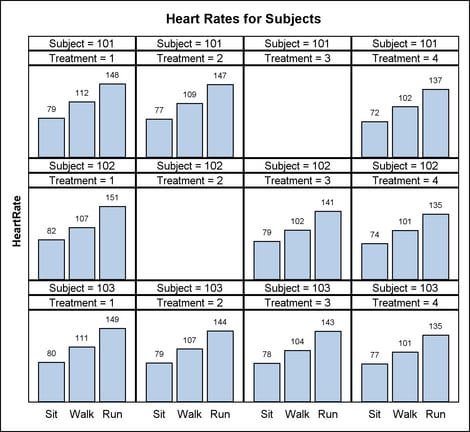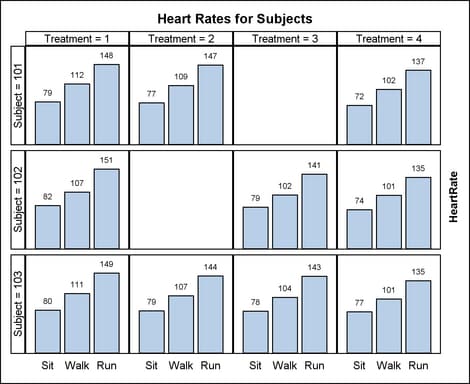Controlling the Interactions of Classifiers
Whenever you have classifiers with a large number
of unique levels, the potential exists for generating a large number
of cells in the panel. If you do not want to see all classification
levels, you can limit the crossings by using a WHERE expression when
creating the input data. Or, you can use a WHERE expression as part
of the PROC SGRENDER step that renders the graph.
Appearance of the Last Panel
If you
set the ROWS= and COLUMNS= options to define a relatively small grid,
PROC SGRENDER automatically generates as many separate panels as it
takes to exhaust all the classification levels. Depending on the grid
size and total number of classification levels, one or more empty
cells might be created on the last panel to complete the grid. For
example, if there are seven classification levels and you define a
2x2 grid, two panels are created (with different names), and the last
panel contains one empty cell:
layout datapanel classvars=(product_category) /
rows=2 columns=2
headerlabeldisplay=value
rowaxisopts=(griddisplay=on offsetmin=0
display=(tickvalues) linearopts=(tickvalueformat=dollar12.));
layout prototype;
barchart x=year y=profit / fillattrs=GraphData1;
endlayout;
sidebar / align=top;
entry "Profit for Selected Sports Items" /
textattrs=GraphTitleText;
endsidebar;
endlayout;
layout datapanel classvars=(product_category) /
rows=2 columns=2
skipemptycells=true
headerlabeldisplay=value
rowaxisopts=(griddisplay=on offsetmin=0
display=(tickvalues) linearopts=(tickvalueformat=dollar12.));
The SKIPEMPTYCELLS=
option also applies to a DATALATTICE layout. The following output
shows the last panel when Division has two levels and Product has
three levels, while ROWS=2 and COLUMNS=2. When SKIPEMPTYCELLS=FALSE,
the last panel will have a column of empty cells. Entire rows or columns
of empty cells can be removed by setting SKIPEMPTYCELLS=TRUE.
User Control of Panel Generation
It is
possible to control the generation of panels. Consider the following
output, in which each panel displays in its upper-right corner the
current panel number and the total number of panels:
Normally, when the number of cells to be created in a
panel is greater than the defined panel size in the template (rows
* columns), then the SGRENDER procedure automatically produces the
number of panel graphs that are necessary to draw all of the cells
in the data. However, you can instruct the template to create only
one panel, which is specified by the PANELNUMBER= option. This feature
can be used to control the creation of the panels.
For example,
the preceding panels were generated with the following template code,
which uses the NMVAR statement to declare macro variables that will
resolve as numbers. The PANELNUMBER=PANELNUM setting is a directive
indicating which panel to produce. The ENTRYTITLE statement changes
as the panel number changes. For more information on how to pass information
to a template at runtime, see Using Dynamics and Macro Variables to Make Flexible Templates.
proc template; define statgraph panelgen; nmvar PANELNUM TOTPANELS ROWS COLS YEAR; begingraph; entrytitle halign=right "Panel " PANELNUM " of " TOTPANELS / textattrs=GraphFootnoteText; layout datapanel classvars=(product division) / rows=ROWS columns=COLS cellheightmin=50 cellwidthmin=50 skipemptycells=true columnaxisopts=(type=time timeopts=(tickvalueformat=month.)) rowaxisopts=(griddisplay=on) panelnumber=PANELNUM; layout prototype; seriesplot x=month y=actual / lineattrs=GraphData1; endlayout; sidebar / align=top; entry "Office Furniture Sales for " YEAR / textattrs=GraphTitleText; endsidebar; endlayout; endgraph; end; run;
Now that
the template is defined, a macro is needed to compute the number of
panels that will be generated, execute PROC SGRENDER an appropriate
number of times, and initialize the macro variables that are referenced
in the template. The macro parameters ROWS and COLUMNS allow different
grid sizes to be used. The graph size changes based on the grid size.
%macro panels(rows=1,cols=1,year=1994);
%local div_vals prod_vals panels totpanels panelnumber;
/* find the number of unique values for the classifiers */
proc sql noprint;
select n(distinct division) into: div_vals from sashelp.prdsale;
select n(distinct product) into: prod_vals from sashelp.prdsale;
quit;
/* compute the number of panels based on input rows and cols */
%let panels=%sysevalf(&div_vals * &prod_vals / (&rows * &cols));
%let totpanels=%sysfunc(ceil(&panels)); /* round up to next integer */
ods graphics / reset ;
ods listing gpath="C:\temp" image_dpi=200;
%do panelnum=1 %to &totpanels;
ods graphics / imagename="Panel&panelnum"
width=%sysevalf(200*&cols)px height=%sysevalf(200*&rows)px;
proc sgrender data=sashelp.prdsale template=panelgen;
where country="U.S.A." and region="EAST" and year=&year;
run;
%end;
%mend;
The three
panels that are shown at the beginning of this section were produced
with the following macro call:
%panels(rows=2,cols=2)
Sparse Data
Multiple
classifiers sometimes have a hierarchical relationship, which results
in very sparse data when the classifier values are crossed. For example,
consider the following LAYOUT DATAPANEL statement:
layout datapanel classvars=(state city) / rows=4 columns=5;
Assume
that the data for the STATE and CITY classifiers contains information
for 20 states and their capitals. How many panels would you expect
to produce? One, or twenty? Or 400?
The answer
is one panel, which is the desired result. A single panel is produced
because even though the default DATAPANEL layout attempts to generate
a complete Cartesian product of the crossing values (400 STATE*CITY
crossings in this case), it does not create panel cells for crossings
that have no data. The SPARSE= option controls whether panel cells
are created when you have no observations for a crossing, and by default
SPARSE=FALSE.
The DATALATTICE
layout does not support a SPARSE= option. The DATALATTICE creates
a row / column for each unique value of the ROWVAR / COLUMNVAR. So
a cell is created for all crossings of the two variable values, thus
creating 400 cells.
Sometimes
there are unexpected gaps in the data when classification variables
are crossed. For example, suppose you are conducting a study where
a number of subjects each receives over time four treatments that
might lower the subject's heart rate after various amounts of physical
activity. However, assume that Subject 101 didn't get Treatment 3,
and Subject 102 didn't get Treatment 2. In this case, when you create
a DATAPANEL layout presenting four treatments for three subjects per
panel, the expected alignment of the columns does not work:
In this
situation, you can generate a placeholder cell whenever a subject
misses a treatment. To do so, specify SPARSE=TRUE for the layout panel.
proc template;
define statgraph sparse;
begingraph / designwidth=490px designheight=450px;
entrytitle "Heart Rates for Subjects";
layout datapanel classvars=(subject treatment) /
columns=4 rows=3
cellheightmin=50 cellwidthmin=50
skipemptycells=true
sparse=true
columnaxisopts=(display=(tickvalues))
rowaxisopts=(display=(label) offsetmin=0);
layout prototype;
barchart x=task y=heartrate / barlabel=true;
endlayout;
endlayout;
endgraph;
end;
run;
The SPARSE=
option does not apply to DATALATTICE layouts because they are inherently
sparse. When you specify two classifiers, the DATALATTICE layout manages
this situation automatically.
proc template;
define statgraph datalattice;
begingraph / designwidth=490px designheight=400px;
entrytitle "Heart Rates for Subjects";
layout datalattice rowvar=subject columnvar=treatment /
rows=3 rowgutter=5px
cellheightmin=50 cellwidthmin=50
rowheaders=left
skipemptycells=true
columnaxisopts=(display=(tickvalues))
rowaxisopts=(display=none displaysecondary=(label) offsetmin=0);
layout prototype;
barchart x=task y=heartrate / barlabel=true;
endlayout;
endlayout;
endgraph;
end;
run;
